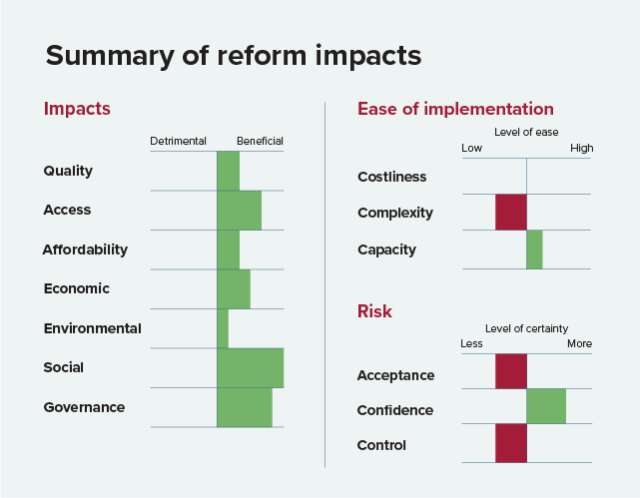Maximise social and economic community benefits by supporting shared use of social infrastructure through future agreements and capital funding programs prioritising shared use of facilities.
- No regrets

Key messages
Productive partnerships are vital for providing effective social infrastructure and enabling more equitable access to services.
Effective cross-government systems help to maximise social, economic and environmental outcomes for communities.
New consistent governance models are required to lead social infrastructure partnerships across jurisdictions.
The benefits of collaborative strategic planning and the shared use of social infrastructure include more connected and healthier communities, better use of assets and optimised government investment.
Co-locating facilities in health and education innovation precincts will lead to more integrated, accessible and higher-quality services and unlock economic benefits.
Cost-effective social infrastructure and services that communities value can be delivered through new models and operating processes that create efficiencies and drive innovation.
What are the impacts?
Forming collaborative partnerships to deliver effective social infrastructure will improve service quality and access for communities.
A coordinated approach to planning and delivering social infrastructure can improve affordability and deliver significant cost savings through shared-use community facilities.
Integrated and early strategic planning supports strong cross-sector governance to deliver the right services in the right places, enabling effective service delivery and economic efficiencies and attracting investment through innovation precincts.
Making effective use of dedicated infrastructure agencies will improve transparency in the system and optimise asset use, enhancing social outcomes.
How easy is it to implement?
Governments recognise a customer service approach improves collaboration. Governments and industry have the capacity to deliver place-based partnerships though harmonisation across jurisdictions. However, this will increase complexity.
Integrating an initial business case and procurement planning may increase initial costs. However, the reform will improve capital outcomes.
Streamlined payment systems and insurance/security arrangements are needed to enable more third-party access to assets. This will involve implementation costs for governments, but will open up new revenue streams for agencies and improve affordability for communities.
How certain are the outcomes?
Connecting infrastructure pipelines with place-based outcomes will improve community confidence in government and industry to deliver the reform.
There must be government control and close engagement to reduce risk, embed higher levels of collaboration and implement effective governance structures that enable new models of delivery and operation.
Changes to service delivery models may reduce the level of trust and lead to some contention in the community. Clear and transparent engagement will improve acceptance of the reform.
| Governance |
Shared use framework
|
| Economic |
Integrated innovation precincts
|
| Governance |
Innovative social infrastructure
|
| Governance |
Social infrastructure assets
|
Read more about this recommendation in 8.2 Partnerships to build communities in the 2021 Australian Infrastructure Plan.
Reform implementation pathway
This recommendation comprises of outcomes and activities, which form the reform's implementation pathway.
The implementation pathway is designed to guide change agents on the supporting activities necessary to achieve the overall reform.
For each outcome and activity, we propose change agents to act as:
- Proposed sponsor: facilitate, coordinate and champion the recommendation
- Proposed lead: deliver specific activities or lead related outcomes
- Support: share ownership, contributions or knowledge to enable the reform process.
Allow community access outside core operating hours by developing shared-use plans for new and upgraded social infrastructure such as health facilities, schools, VET, TAFE, universities and sporting facilities.
5-10 years
Support shared use of social infrastructure by establishing national principles for place-based, cross-agency infrastructure governance.
5-10 years
Promote shared use of social infrastructure by developing incentives and measures that support agencies to implement shared-use arrangements and place-based, collaborative planning and delivery.
5-10 years
Increase community access to social infrastructure by benchmarking, compiling and sharing best practice examples of shared-use models that could be adapted or scaled nationally.
0-5 years
Enable place-centric TAFE developments by developing principles to support this approach, including collaborative and shared-use opportunities. Review existing TAFE assets against these principles and migrate new or refurbished assets where there are benefits.
5-10 years
Enable the use of infrastructure during crises by identifying and funding fit-for-purpose facilities that would be available for rapid multi-purposing and shared use at these times.
0-5 years
Support third-party use by establishing insurance and security arrangements, payment systems and associated services.
5-10 years
Enable a shift in agencies adopting shared-use models by including principles for maximising shared use and associated community outcomes in business case policies.
5-10 years
Increase economic and social benefits by implementing strategic planning governance structures for health and education precincts, and innovative procurement and delivery models. Specialised agencies should also be established to deliver major social infrastructure capital projects.
5-10 years
Drive the development of health and education precincts and innovation districts by developing and implementing place-based governance agreements that involve associated local institutions and community representatives.
5-10 years
Yield the benefits of innovation districts by adopting a precinct maturity model to:
- assess the maturity of existing health and education precincts
- prioritise precincts to move along the precinct maturity pathway
- develop investment attraction strategies, master plans and incentives to attract aligned industry sectors into precincts
- include social and affordable rental housing in innovation districts.
5-10 years
Promote and accommodate innovative approaches to procuring social infrastructure delivery services, including updating existing Public Private Partnership guidelines and models.
5-10 years
Deliver better capital outcomes by establishing standalone infrastructure agencies and major project offices for significant sector portfolios.
5-10 years